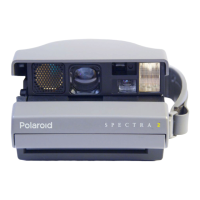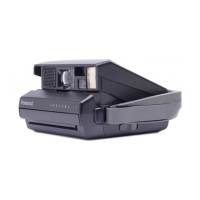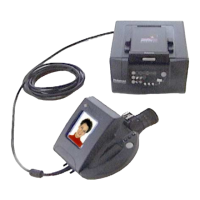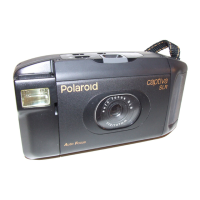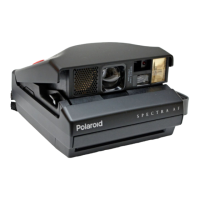
Do you have a question about the Polaroid Spectra AF and is the answer not in the manual?
| Brand | Polaroid |
|---|---|
| Model | Spectra AF |
| Category | Digital Camera |
| Language | English |
Measures distance to subject using sound waves for focus.
Measures ambient and flash light for exposure control.
Three-element lens system with ten-zone focusing.
Button to focus/meter (half-press) and take picture (full-press).
Adjusts picture brightness to lighten or darken.
Activates the camera's self-timer function.
Disables the automatic autofocus system.
Turns off the automatic flash system.
Instructions for opening the camera body to prepare for use.
Ensuring switches are set correctly for automatic operation.
Procedure for inserting a new film pack into the camera.
Guidance on optimal subject distance for clear pictures.
How to hold the camera and press the shutter button.
Steps to eject and replace used film cartridges.
How the autofocus system uses sound waves for sharp images.
Ensuring unobstructed sound path for accurate focusing.
Tips for photographing more than one person.
How to disable autofocus when shooting through glass.
Interpreting symbols and numbers shown in the viewfinder.
Green symbol indicating optimal shooting conditions.
Yellow symbol and tone warning of shooting problems.
Interpreting viewfinder numbers for focus and flash range.
How the flash blends with scene light for best results.
Understanding the green light indicating flash readiness.
Optimal indoor and outdoor distances for flash photography.
Adjusting picture brightness for lighter or darker results.
Adjusting exposure for highly reflective scenes.
Using the self-timer for including yourself in photos.
Steps for setting up and activating the self-timer.
Understanding the beeps and red light signals.
How to cancel the self-timer countdown.
How to turn off autofocus and flash systems.
Requirements for daylight and subject distance.
Turning AF and flash systems back on after shooting.
Proper methods for cleaning the camera lens.
Handling and developing Spectra pictures gently.
Recommendations for optimal film storage and usage temperatures.
Contact information for Polaroid customer support and service.
Details on warranty coverage, terms, and service.
Reasons for blurry images like subject centering and focus.
Methods to fix blurry pictures by adjusting framing and support.
Troubleshooting issues with spots or bar patterns on prints.
Reasons for damaged prints like shaking or improper handling.
Solutions for preventing damage to developing prints.
Diagnosing and fixing underexposed subjects.
Diagnosing and fixing underexposed backgrounds.
Addressing blue or red/yellow tints in pictures due to temperature.
Tips on using vibrant colors and props for scene interest.
Recommended distances for taking pleasing portraits of people.
Advice on choosing light or simple backgrounds.
Using foreground elements for depth in landscapes.
Dimensions, weight, power source, and shutter button.
Specifications for the lens and programmed flash.
Information on film size, speed, and type.
Details on AF, photocell, and aperture/shutter.
